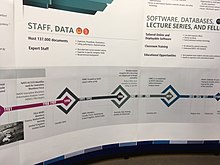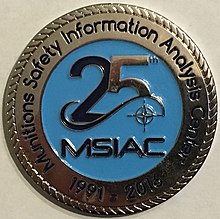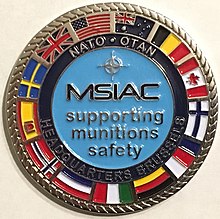Information and analysis center on the security of NATO ammunition – Wikipedia
The NATO ammunition information and analysis center ( CIASM , or in English, Msiac : Munitions Safety Information Analysis Center ) is a NATO project directly funded by its member countries, some of which are not members of the Alliance. Thirteen countries are members of the project: Australia, Belgium, Canada, Finland, France, Germany, Italy, the Netherlands, Norway, Spain, Sweden, Switzerland, United Kingdom and the United States of America.
Pilot project: NATO information center on insensitive ammunition [ modifier | Modifier and code ]
(in English, Nato Insensitive Munition Information Center or Pilot-nimic )
The , on the basis of a memorandum of understanding, France, the Netherlands, Norway, the United Kingdom and the United States decided to create the Pilot-Nimic project (NATO Information Center On mitigated risk ammunition (Murat), in English, Nimic = NATO Insensitive Munitions Information Center ).



The purpose of this organization was to help national and international programs for the development of attenuated risk munitions (MURAT) [ first ] . The idea of the NIMIC was born during a workshop in the NATO AC/310 group “Information exchange workshop on mitigated risk ammunition” in 1986 and was actively supported by the president of AC/310 , the IGA Michel Thévenin and the United States representative within this group, the D r R. Derr [ 2 ] . In order to help developments in attenuated risk ammunition within NATO countries, the former NATO AC/310 group (group working on security and ability to service ammunition and materials explosives) largely supported the creation of this pilot project.
The Nimic pilot project office was located in the applied physics laboratory ( Applied Physics Laboratory ) (APL) dependent on Johns-Hopkins University ( Johns Hopkins University ), located in Laurel, in the state of Maryland, in the United States of America. The initial team was made up of a project director and 5 technical experts, a structure relatively similar to that of MSIAC today (see below). At the end of 1989, little time after the project was created, Canada joined the organization.
Installation in Brussels and enlargement of Nimic [ modifier | Modifier and code ]
After two years of operation, the project settled at the NATO headquarters in Brussels and officially became the Nimic . Spain and Australia joined the organization in 1994, Portugal and Italy did the same year (1995). Portugal will quickly leave the organization (in 1998). Denmark was also a member for 5 years from 1999 to 2004.
Grouping of AC/258 and AC/310 and transition to CIASM [ modifier | Modifier and code ]
In never 2003 the Conference of National Armaments Directors (CDNA) Group on ammunition safety (AC/326) (known as Casg for CNAD Ammunition Safety Group) was born from the merger of 2 groups, AC/258, expertise group on security in Storage and transport of ammunition and explosive materials, and AC/310, group responsible for safety and ability to the service of ammunition and explosive materials [ 3 ] .
In order to take this change into account, it was decided to modify and extend the activities of the NIMIC to put a wider emphasis on the safety of ammunition. Therefore, the transition to a Information and analysis center for ammunition Was operated in the spring of 2003 with the creation of the CIASM pilot project.
At the end of 2004, after a successful transition period, the Information and analysis center for ammunition NATO has been officially created. The official creation date is the . Germany then became a member in 2005. Belgium became a member in 2013.
The CIASM includes a steering committee, national interlocutors (national focal point) and the information and analysis center as such. The steering committee consists of a representative by a member country, and an elected president. He is responsible for the implementation of the Memorandum of Agreement that governs the Center, as well as the development of its lines of work. These axes are carried out daily by the project manager and the center team.
The NATO Munition Information and Analysis Center offers technical consulting services in the field of ammunition security to its member countries.
The areas covered by the CIASM include:
- Energy materials – explosives, weapons powders, propergols, and pyrotechnic compositions;
- Military heads – design, production, tests, terminal effects, rocket systems;
- Propulsion – design, production, tests, ignition systems;
- Munition at the system level – integration into weapons systems, analysis of threat and dangers, security and ability to service, demilitarization and destruction;
- Logistics – regulations and safety principles applicable to storage, transport, risk analysis and classification in the risk division;
- Materials science.
In these areas, the CIASM fulfills the following functions [ 4 ] :
- Development of the database collects technical information;
- Technical advice;
- Response to surveys from government organizations or industries in member countries;
- Preparation of reports reflecting the state of art in its areas of expertise;
- Organization of technical conferences [ 5 ]
- Development and distribution of software and databases [ 6 ] , [ 7 ] ;
- Round Robin type test organization [ 8 ] ;
- Development and maintenance of a network of experts thanks to the sponsorship of workshops and seminars, as well as by the creation of virtual working groups.
- PNIMIC Newsletter 1989 , first , Johns Hopkins University Laurel Maryland, United States
- PNIMIC Newsletter 1989 , 3 , Johns Hopkins University Laurel Maryland, United States
- [first] CNAD Ammunition Safety Group (AC/326)Homepage
- MSIAC25: Celebrating 25 Years Helping Member Nations Improve Munitions Safety on YouTube
- [2] MSIAC Newsletter 2 2008
- E.-C. Koch, EMC 3.8 – Energetic Materials Compendium – A Tool for Research, Development and Design, 40th International Annual Conference of ICT , 23–26 June, 2009 , Karlsruhe, Germany, V-1.
- E. Lapébie, F. Grannec, P.-F. Péron, Modelling of Warhead Response to Projectile Impact with TEMPER Software, 40th International Annual Conference of ICT , 23–26 June, 2009 , Karlsruhe, Germany, P-116.
- [3] R. M. Doherty, D. S. Watt, Relationship between RDX Properties and Sensitivity, Propellants Explos. Pyrotech. 33 2008 4 – 13.
Related articles [ modifier | Modifier and code ]
Bibliography [ modifier | Modifier and code ]
Recent Comments